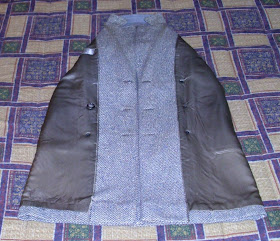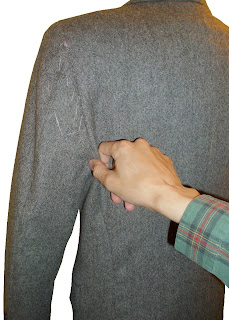("Springtime and the Average Guy," part three of three)
Chapter 60
Dress Like A Grownup! continues its miniseries on the clothes of Springtime this week, by appealing again to the Average Guy. As my little blog builds worldwide fame and acclaim amongst my ever-growing cadré of readers and followers, there will always be a man who is starting from Square One -- the man who comes to that epiphanal moment in his life, when he looks at himself in the mirror and says something along the lines of "Egad; I'm dressed like a ten year old!" And then decides to do something about it.
But, facing the daunting task of absorbing over a year's worth of information can be overwhelming for the novice. What is the Average Guy to do? Go back to the very beginning and read every blog installment, in sequence -- or at the very least, to read "Dress Like A Grownup! Volume One," the bookbound distillation of our Dressing the Average Guy series? It will take weeks if you follow the directions contained therein. Is there a short-cut that can be taken in the meantime, that will suffice to get the Average Guy through the Spring season with minimal effort?
Why, yes, there is. What I am about to impart to you may change your life and the way you think about clothes. You, the Average Guy, can slingshot your sartorial training far forward in one simple step, while you build your discipline and educational background for being truly well dressed, in your own time. You don't have to understand the whys and wherefores, the history or the theory. Just go through the motions for now, and fill in the blanks as you go.
If there was ever a "Dressing Well for Dummies," this is it. Education optional, plug-and-play simplicity. It involves the purchase of exactly one item to supplement your existing wardrobe:
One lightweight cotton or wool sports jacket. That's all. Your Spring can be fundamentally transformed. It's like magic.
If you are a student on your Dress Like A Grownup! path to sartorial excellence™, so much the better! Students are notoriously light on discretionary funds, and spare scratch to spend on new and better clothing is hard to come by, what with more pressing matters to attend to, like beer. textbooks and lab fees. The purchase of this one jacket can stand in for a good half-dozen or more uses, and, as a rising tide lifts all boats, will make your current wardrobe that tiny bit more acceptable by its presence -- that is, until you can afford to supplement your wardrobe with, well, real clothes.
First, let's look at just what you need in this aforementioned "sports jacket." It may be of a light and neutral color and pattern, preferably notch-lapelled and single-breasted, to match a variety of outfits. It should be of a light cotton or wool, either unlined, half-lined, or very lightly constructed. This is spring, after all, and if you are unused to wearing anything but a greasy tee-shirt, a light jacket will cause you the least amount of discomfort. And it needs to fit. It also doesn't have to be new, if you can find something serviceable at the secondhand store. You needn't worry about the details of style at this point, as this is basically "emergency wear" to get you through the first weeks of your newly-found adultitude without undue duress. You will undoubtedly replace it as you discover your sartorial center in time; and you will not wear it beyond mid-summer in any case.
Now, we'll demonstrate how this simple jacket alone can transform the average man's wardrobe into something approaching acceptability.
The baseline for mediocrity in men's wear the world over is an untucked tee-shirt, hip-hugger jeans, and some form of flippity-flop footwear. Atrocious, you'll agree. Now add the jacket. Voila -- your outfit is now "ironically casual." Still awful, but now less so.
Let's up the ante a bit, to what most men call "dressing up," to a polo shirt, khaki chinos, and athletic shoes. An adult society might call this barely acceptable attire for even mowing your lawn. But put your jacket on, and hey-presto, you've crossed the line into a fine sort of sporty-casual, easy as that.
Say you're really putting on the Ritz, going out to dinner for instance. You'll wear your "good jeans," and a short-sleeved shirt. You thought that was just fine before...but add your jacket, and alakazam! Instant spring-dressy.
Let's say it's chilly and drizzly, and you put on your usual cold-weather gear: your "warm jeans" and a sweatshirt. But wait! The addition of your jacket makes a sharp rainy-day ensemble!
Now let's go the other direction: warm and sunny. What would you wear? Cargo shorts and a short-sleeve shirt, perhaps? Not so fast -- add that same light jacket, and you've just made a Bermuda suit!
Surely there can't be more...but yes! You're at the beach, on vacation, soaking up the rays, or at the cabana. Swim trunks and flip flops are the norm. You can't mean -- but I can! Trunks and a jacket? Absolutely! Easier to remove than a shirt, with better flow-through, and no sunburning. Bonus: worn with a scarf, it's a classic resort look from the '40s.
So you see, there's no limit to what a simple jacket can do, and no situation that doesn't benefit from wearing one. It's simple, easy, and universal. It's not the end of the road -- far from it, but it's a good first step to dressing well.
Click here to go to the next essay chronologically.
Click here to go back to the previous essay chronologically.
Click here to go back to the beginning.
Click here to go to the next essay chronologically.
Click here to go back to the previous essay chronologically.
Click here to go back to the beginning.

















































